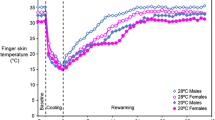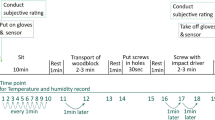Abstract
Objectives: To compare effects of waterproof covering on finger skin temperature (FST) and subjective hand pain during immersion tests using cold water at 10°C, 12°C and 15°C. In the (Draft International Standard) of the International Organization for Standardization (ISO/DIS 14835-1), a water temperature of 12°C and use of water covering are proposed. Methods: Six healthy male subjects took part in the immersion tests and immersed both hands into water at 10°C, 12°C and 15°C for 5 min, repeatedly, with waterproof covering (polyethylene gloves) or without (bare hands). The FST data from middle fingers and subjective pain scores for hand pain were analyzed. Furthermore, the test with water at 12°C was repeated to assess the repeatability of the test. Results: The glove and water temperature factors for FST were significant at every minute from 1 min during immersion up to 2 min after recovery, showing higher values for waterproof covering than for bare hands and showing lowest values for water temperature of 10°C and highest for 15°C. The glove and water temperature factors for subjective pain score were significant at the 1-min and 2-min points during immersion, showing lower scores for waterproof covering than for bare hands and showing highest scores for water temperature of 10°C and lowest for 15°C. The results of the first and second tests using water of 12°C showed no systematic difference in FST and hand pain between the tests, with a few exceptions. Conclusions: Subjective pain during the cold immersion test with polyethylene gloves and water at 12°C can be reduced, while the differences in FST between water temperatures of 10°C and 12°C were small or not apparent at some points during immersion and recovery. The test also seems to be suitable for repeatability. Further investigation on hand–arm vibration syndrome (HAVS) patients to validate the use of the immersion test with gloves to obtain sufficient data for diagnostic value is required.



Similar content being viewed by others
References
Bartelink ML, Wollersheim H, Jansen RWM, Theeuwes A, Thien TH (1993) Reproducibility of the finger cooling test. Microvasc Res 45:65–73
Bland JM, Altman DG (1986) Statistical methods for assessing agreement between two methods of clinical measurement. Lancet 1:307–310
Bylund SH, Burström L (2003) Power absorption in women and men exposed to hand–arm vibration. Int Arch Occup Environ Health 76:313–317
Carnicelli MVF, Griffin MJ, Rice CG (1992) Repeatability of finger systolic blood pressure and finger rewarming. In: Proceedings, 6th international conference on hand–arm vibration, Bonn, Germany, pp 101–109
Harada N (1987) Esthesiometry, nail compression and other function tests used in Japan for evaluating the hand–arm vibration syndrome. Scand J Work Environ Health 13:330–333
Harada N (2002) Cold-stress tests involving finger skin temperature measurement for evaluation of vascular disorders in hand–arm vibration syndrome: review of the literature. Int Arch Occup Environ Health 75:14–19
Harada N, Matsumoto T (1984) Validity of various function tests performed in Japan as a screening test for vibration syndrome. Int Arch Occup Environ Health 54:283–293
Harada N, Iwamoto M, Laskar MS, Hirosawa I, Nakamoto M, Shirono S, Wakui T (1998) Effects of room temperature, seasonal condition and food intake on finger skin temperature during cold exposure test for diagnosing hand–arm vibration syndrome. Ind Health 36:166–170
Harada N, Yoshimura M, Laskar MS (1999) A minireview of studies conducted in Japan using finger-skin temperature during cold-stress tests for the diagnosis of hand–arm vibration syndrome. Int Arch Occup Environ Health 72:330–334
ISO/DIS 14835–1 (2004) Mechanical vibration and shock—cold provocation tests for the assessment of peripheral vascular function—part 1: measurement and evaluation of finger skin temperature
Kent P, Wilkinson D, Parkin A, Kester RC (1991) Comparing subjective and objective assessments of the severity of vibration induced white finger. J Biomed Eng 13:260–262
Lindsell CJ, Griffin MJ (2001) Interpretation of the finger skin temperature response to cold provocation. Int Arch Occup Environ Health 74:325–335
SPSS Inc (2001) SPSS advanced models 11.0J. SPSS, Chicago
Suizu K, Inoue M, Fujimura T, Morita H, Inagaki J, Kan H, Harada N (2004) Influence of waterproof covering on finger skin temperature and hand pain during immersion test for diagnosing hand–arm vibration syndrome. Ind Health 42:79–82
Yoshimura M, Laskar MS, Shirono S, Iwamoto M, Harada N (2000) Finger skin temperature during cold-stress tests involving water at 10°C for 10 minutes and at 15°C for 3 minutes for diagnosis of hand–arm vibration syndrome. In: Proceedings, 35th Meeting of the United Kingdom Group on Human Response to Vibration, Southampton, pp 51–53
Acknowledgments
We wish to thank Dr. M. Inoue, Dr. M.S. Laskar and K. Yokoyama at the Department of Hygiene of Yamaguchi University School of Medicine, Japan for their helpful discussions and support in preparation of this article.
Author information
Authors and Affiliations
Corresponding author
Rights and permissions
About this article
Cite this article
Suizu, K., Harada, N. Effects of waterproof covering on hand immersion tests using water at 10°C, 12°C and 15°C for diagnosis of hand–arm vibration syndrome. Int Arch Occup Environ Health 78, 311–318 (2005). https://doi.org/10.1007/s00420-004-0587-1
Received:
Accepted:
Published:
Issue Date:
DOI: https://doi.org/10.1007/s00420-004-0587-1




